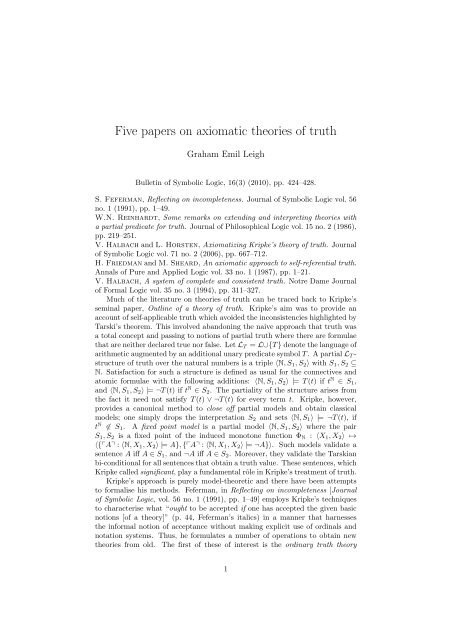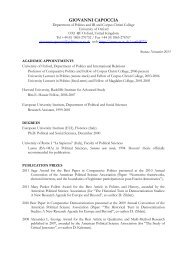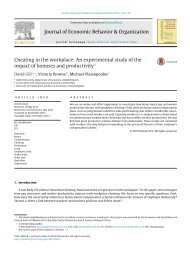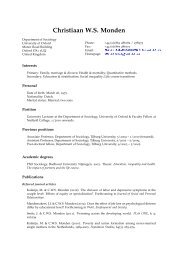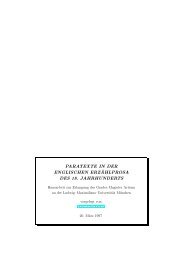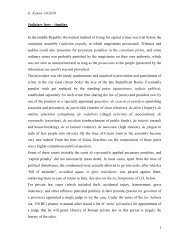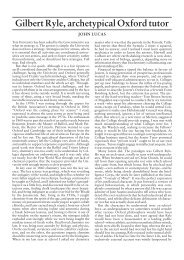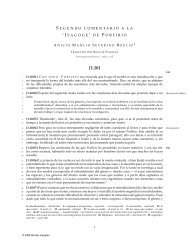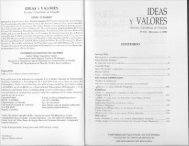Five papers on axiomatic theories of truth - Personal Pages Index
Five papers on axiomatic theories of truth - Personal Pages Index
Five papers on axiomatic theories of truth - Personal Pages Index
Create successful ePaper yourself
Turn your PDF publications into a flip-book with our unique Google optimized e-Paper software.
<str<strong>on</strong>g>Five</str<strong>on</strong>g> <str<strong>on</strong>g>papers</str<strong>on</strong>g> <strong>on</strong> <strong>axiomatic</strong> <strong>theories</strong> <strong>of</strong> <strong>truth</strong><br />
Graham Emil Leigh<br />
Bulletin <strong>of</strong> Symbolic Logic, 16(3) (2010), pp. 424–428.<br />
S. Feferman, Reflecting <strong>on</strong> incompleteness. Journal <strong>of</strong> Symbolic Logic vol. 56<br />
no. 1 (1991), pp. 1–49.<br />
W.N. Reinhardt, Some remarks <strong>on</strong> extending and interpreting <strong>theories</strong> with<br />
a partial predicate for <strong>truth</strong>. Journal <strong>of</strong> Philosophical Logic vol. 15 no. 2 (1986),<br />
pp. 219–251.<br />
V. Halbach and L. Horsten, Axiomatizing Kripke’s theory <strong>of</strong> <strong>truth</strong>. Journal<br />
<strong>of</strong> Symbolic Logic vol. 71 no. 2 (2006), pp. 667–712.<br />
H. Friedman and M. Sheard, An <strong>axiomatic</strong> approach to self-referential <strong>truth</strong>.<br />
Annals <strong>of</strong> Pure and Applied Logic vol. 33 no. 1 (1987), pp. 1–21.<br />
V. Halbach, A system <strong>of</strong> complete and c<strong>on</strong>sistent <strong>truth</strong>. Notre Dame Journal<br />
<strong>of</strong> Formal Logic vol. 35 no. 3 (1994), pp. 311–327.<br />
Much <strong>of</strong> the literature <strong>on</strong> <strong>theories</strong> <strong>of</strong> <strong>truth</strong> can be traced back to Kripke’s<br />
seminal paper, Outline <strong>of</strong> a theory <strong>of</strong> <strong>truth</strong>. Kripke’s aim was to provide an<br />
account <strong>of</strong> self-applicable <strong>truth</strong> which avoided the inc<strong>on</strong>sistencies highlighted by<br />
Tarski’s theorem. This involved aband<strong>on</strong>ing the naive approach that <strong>truth</strong> was<br />
a total c<strong>on</strong>cept and passing to noti<strong>on</strong>s <strong>of</strong> partial <strong>truth</strong> where there are formulae<br />
that are neither declared true nor false. Let LT = L∪{T } denote the language <strong>of</strong><br />
arithmetic augmented by an additi<strong>on</strong>al unary predicate symbol T . A partial LT -<br />
structure <strong>of</strong> <strong>truth</strong> over the natural numbers is a triple 〈N, S1, S2〉 with S1, S2 ⊆<br />
N. Satisfacti<strong>on</strong> for such a structure is defined as usual for the c<strong>on</strong>nectives and<br />
atomic formulae with the following additi<strong>on</strong>s: 〈N, S1, S2〉 |= T (t) if t N ∈ S1,<br />
and 〈N, S1, S2〉 |= ¬T (t) if t N ∈ S2. The partiality <strong>of</strong> the structure arises from<br />
the fact it need not satisfy T (t) ∨ ¬T (t) for every term t. Kripke, however,<br />
provides a can<strong>on</strong>ical method to close <strong>of</strong>f partial models and obtain classical<br />
models; <strong>on</strong>e simply drops the interpretati<strong>on</strong> S2 and sets 〈N, S1〉 |= ¬T (t), if<br />
t N ∈ S1. A fixed point model is a partial model 〈N, S1, S2〉 where the pair<br />
S1, S2 is a fixed point <strong>of</strong> the induced m<strong>on</strong>ot<strong>on</strong>e functi<strong>on</strong> ΦN : 〈X1, X2〉 ↦→<br />
〈{A : 〈N, X1, X2〉 |= A}, {A : 〈N, X1, X2〉 |= ¬A}〉. Such models validate a<br />
sentence A iff A ∈ S1, and ¬A iff A ∈ S2. Moreover, they validate the Tarskian<br />
bi-c<strong>on</strong>diti<strong>on</strong>al for all sentences that obtain a <strong>truth</strong> value. These sentences, which<br />
Kripke called significant, play a fundamental rôle in Kripke’s treatment <strong>of</strong> <strong>truth</strong>.<br />
Kripke’s approach is purely model-theoretic and there have been attempts<br />
to formalise his methods. Feferman, in Reflecting <strong>on</strong> incompleteness [Journal<br />
<strong>of</strong> Symbolic Logic, vol. 56 no. 1 (1991), pp. 1–49] employs Kripke’s techniques<br />
to characterise what “ought to be accepted if <strong>on</strong>e has accepted the given basic<br />
noti<strong>on</strong>s [<strong>of</strong> a theory]” (p. 44, Feferman’s italics) in a manner that harnesses<br />
the informal noti<strong>on</strong> <strong>of</strong> acceptance without making explicit use <strong>of</strong> ordinals and<br />
notati<strong>on</strong> systems. Thus, he formulates a number <strong>of</strong> operati<strong>on</strong>s to obtain new<br />
<strong>theories</strong> from old. The first <strong>of</strong> these <strong>of</strong> interest is the ordinary <strong>truth</strong> theory<br />
1
associated with a theory S, labelled Tr(S): a new predicate T0 is added to<br />
S al<strong>on</strong>g with axioms expressing that T0 behaves as a <strong>truth</strong> predicate for the<br />
language <strong>of</strong> S and all axiom schemata are extended to include the augmented<br />
language. Iterati<strong>on</strong> <strong>of</strong> the underlying operati<strong>on</strong>, S ↦→ Tr(S), up to an ordinal<br />
α yields what has since become known as the ramified hierarchy <strong>of</strong> <strong>truth</strong>, RTα;<br />
<strong>on</strong>e has an hierarchy <strong>of</strong> predicates, {Tβ : β < α}, each a <strong>truth</strong> predicate for the<br />
language encompassing the predicates <strong>of</strong> smaller index. The author remarks that<br />
RTα and the ramified hierarchy at level α, RAα, are inter-translatable, though<br />
the pro<strong>of</strong> Feferman refers to is missing from the paper. The reducti<strong>on</strong> <strong>of</strong> RAα to<br />
RTα, however, is relatively straightforward and a pro<strong>of</strong> <strong>of</strong> the c<strong>on</strong>verse reducti<strong>on</strong><br />
can, essentially, be gleaned from the author’s arguments in secti<strong>on</strong> 4.3. A direct<br />
pro<strong>of</strong> using Feferman’s techniques can be found in secti<strong>on</strong> V.18 <strong>of</strong> Halbach’s<br />
book Axiomatische Wahrheitstheorien [Akademie Verlag, Berlin, 1996].<br />
By replacing the basic <strong>truth</strong> predicate <strong>of</strong> Tr(S) with self-applicable noti<strong>on</strong>s<br />
<strong>of</strong> <strong>truth</strong> Feferman is able to define str<strong>on</strong>ger <strong>theories</strong> <strong>of</strong> <strong>truth</strong>. The (weak) reflective<br />
closure <strong>of</strong> S, Ref(S), extends S with predicates T and F for <strong>truth</strong> and<br />
falsity. The predicates are defined to behave compositi<strong>on</strong>ally <strong>on</strong> the language<br />
LS ∪ {T, F } and hence allow self-applicability. Furthermore all axiom schemata<br />
<strong>of</strong> S are extended to also incorporate the new predicates. The theory Ref(S) is<br />
classical and starting from certain models <strong>of</strong> S, Feferman shows how <strong>on</strong>e may<br />
c<strong>on</strong>struct closed-<strong>of</strong>f Kripke models <strong>of</strong> Ref(S) by interpreting F (A) as T (¬A).<br />
Thus, if Ref(S) ⊢ T (A), A is valid in all fixed point models <strong>of</strong> S and it is in this<br />
sense that <strong>truth</strong> and falsity in Ref(S) can be viewed as partial. If S is formulated<br />
as a schematic theory with a free predicate symbol P and a rule <strong>of</strong> the form<br />
P -Subst: ‘from A(P ) infer A(B) for any formula B’, Feferman also c<strong>on</strong>siders the<br />
str<strong>on</strong>g reflexive closure <strong>of</strong> S(P ), Ref ∗ (S(P )), in which the <strong>truth</strong> predicate also<br />
applies to P and <strong>on</strong>e has a suitably modified form <strong>of</strong> P -Subst. The str<strong>on</strong>g reflexive<br />
closure forms a significantly str<strong>on</strong>ger theory than the weak versi<strong>on</strong>. The<br />
main theorem <strong>of</strong> the paper is that Ref(PA) ≡ RA
the countable ordinals, the theory <strong>of</strong> real numbers and fragments <strong>of</strong> set theory.<br />
In the case <strong>of</strong> set theory, set-theoretical reflecti<strong>on</strong> principles that are expressible<br />
with the aid <strong>of</strong> a <strong>truth</strong> predicate become candidates for inclusi<strong>on</strong> as further<br />
axioms, providing a noti<strong>on</strong> <strong>of</strong> reflective closure specific to set theory.<br />
Related to Kripke’s noti<strong>on</strong> <strong>of</strong> significance is Gödel’s idea that c<strong>on</strong>cepts such<br />
as ‘meaningfully applicable’ need not be meaningful when applied to arbitrary<br />
arguments. By interpreting ‘A is meaningfully applicable to x’ as ‘A(¯x) is<br />
significant’, Reinhardt, in his paper Some remarks <strong>on</strong> extending and interpreting<br />
<strong>theories</strong> with a partial predicate for <strong>truth</strong> [Journal <strong>of</strong> Philosophical Logic, vol. 15<br />
no. 2 (1986), pp. 219–251], explores the possibility <strong>of</strong> Kripke’s theory serving as<br />
an implementati<strong>on</strong> <strong>of</strong> Gödel’s suggesti<strong>on</strong>. As there are sentences A for which<br />
the statement ‘it is significant that A is significant’ does not hold in Kripke’s<br />
theory, Reinhardt’s interpretati<strong>on</strong> accords with Gödel’s informal view that the<br />
c<strong>on</strong>cept ‘meaningful’ is partial.<br />
Reinhardt’s main proposal is to view the Kripke-Feferman theory KF, defined<br />
as Ref(PA) plus the axiom stating that <strong>truth</strong> and falsity do not intersect, as<br />
an axiomatisati<strong>on</strong> <strong>of</strong> Kripke’s theory. KF is not itself sound with respect to<br />
fixed point models but its internal theory IKF = {A : KF ⊢ T (A)} is; thus<br />
the author recommends taking KF ⊢ T (A) as a sufficient c<strong>on</strong>diti<strong>on</strong> to declare<br />
A to be true. Reinhardt notes that his proposal has a number <strong>of</strong> desirable<br />
properties for an informal theory <strong>of</strong> <strong>truth</strong> and significance; for example, its<br />
formalisati<strong>on</strong>, ProvKF(T ( ˙x)) → T (x), is significant and can be safely admitted<br />
as true: adding T (∀x[ProvKF(T ( ˙x)) → T (x)]) to KF results in a str<strong>on</strong>ger,<br />
but c<strong>on</strong>sistent, theory and a weaker noti<strong>on</strong> <strong>of</strong> <strong>truth</strong>. The proposal is explored<br />
further by c<strong>on</strong>sidering variants <strong>of</strong> the liar sentence and their c<strong>on</strong>sequences. His<br />
analysis shows that many statements about n<strong>on</strong>-significance are inc<strong>on</strong>sistent<br />
with KF, spreading some light <strong>on</strong> the nature <strong>of</strong> significance and n<strong>on</strong>-significance<br />
within Kripke’s theory. These include the naive ‘it is always significant that<br />
A is significant’ and the more plausible ‘if it is provable in KF that A is not<br />
significant, it is significant that A is not significant’. With this interpretati<strong>on</strong>,<br />
however, KF behaves merely as an instrument for generating the ‘real’ theorems<br />
<strong>of</strong> interest, which all lie within IKF. Reinhardt is clearly aware <strong>of</strong> this and<br />
suggests embarking <strong>on</strong> an analogue <strong>of</strong> Hilbert’s programme, the objective being,<br />
he writes, “to justify the use <strong>of</strong> n<strong>on</strong>significant sentences entirely within the<br />
framework <strong>of</strong> the significant sentences” (p. 225).<br />
With this in mind Reinhardt, in Remarks <strong>on</strong> significance and meaningful<br />
applicability [in: ed. de Alcantara, Mathematical logic and formal systems, Lecture<br />
Notes in Pure and Applied Mathematics, vol. 94 (1985), pp. 227–242], asks<br />
whether, for every A ∈ IKF there is a pro<strong>of</strong> A0, A1, . . . , An <strong>of</strong> A, such that<br />
Ai ∈ IKF for each i < n. This questi<strong>on</strong> is answered negatively by Halbach<br />
and Horsten in the third paper under review, Axiomatizing Kripke’s theory <strong>of</strong><br />
<strong>truth</strong> [Journal <strong>of</strong> Symbolic Logic, vol. 71 no. 2 (2006), pp. 667–712]. It is shown<br />
that for any such pro<strong>of</strong> <strong>of</strong> A ∈ IKF, in fact PA ⊢ A and thus Reinhardt’s goal<br />
cannot be obtained. The result does not preclude IKF from having a natural<br />
axiomatisati<strong>on</strong>, but does dem<strong>on</strong>strate the reliance <strong>on</strong> the ‘ideal’ statements <strong>of</strong><br />
KF to prove the ‘real’ theorems <strong>of</strong> IKF. The classical nature <strong>of</strong> KF provides<br />
a number <strong>of</strong> undesirable features for an axiomatisati<strong>on</strong> <strong>of</strong> Kripke’s theory, not<br />
least <strong>of</strong> which is the discrepancy between its internal and external <strong>theories</strong>. The<br />
authors therefore reject IKF and set themselves the task <strong>of</strong> determining a natural<br />
axiomatisati<strong>on</strong> <strong>of</strong> Kripke’s theory which, they c<strong>on</strong>clude, should be formulated<br />
3
directly in partial logic. Halbach and Horsten are not the first to c<strong>on</strong>sider formal<br />
systems <strong>of</strong> partial logic; the theory they propose is related to systems <strong>of</strong> Scott<br />
and Blamey and formulated in a Gentzen-style two-sided sequent calculus. This<br />
is not the place to explain in detail their system, but it can be recognised as<br />
essentially classical logic with, in place <strong>of</strong> any introducti<strong>on</strong> or eliminati<strong>on</strong> rules<br />
for negati<strong>on</strong>, a rule <strong>of</strong> modus tollens, sequents for double negati<strong>on</strong> eliminati<strong>on</strong><br />
and the curious λ and ¬λ-sequents: λ ⇒ ¬λ and A, ¬A ⇒ λ respectively, where<br />
λ denotes the liar sentence λ ↔ ¬T (λ). The idea behind the ¬λ-sequents is<br />
as sound replacements for the unsound ex falso quodlibet sequents A, ¬A ⇒ ∅.<br />
These peculiar sequents are, however, never utilised and appear unnecessary for<br />
the analysis. On top <strong>of</strong> the logic are added the axioms <strong>of</strong> arithmetic and sequents<br />
corresp<strong>on</strong>ding to the axioms <strong>of</strong> compositi<strong>on</strong>al <strong>truth</strong> used in KF, forming<br />
the system PKF. Halbach and Horsten show that Kripke fixed point structures<br />
form natural models <strong>of</strong> PKF and, moreover, the soundness argument can be<br />
formalised within a sub-theory <strong>of</strong> KF with restricted inducti<strong>on</strong>. By a result due<br />
to Cantini this sub-theory has the same pro<strong>of</strong>-theoretic strength as RA
where between ‘provability’ (which is well understood and somehow insufficient)<br />
and full ‘<strong>truth</strong>’ (which is mysterious and perhaps inherently unstable)” (p. 3).<br />
The main result <strong>of</strong> the paper, that over the base theory there are exactly nine<br />
maximal c<strong>on</strong>sistent subsets <strong>of</strong> the Opti<strong>on</strong>al Axioms, is presented in the form <strong>of</strong><br />
a sequence <strong>of</strong> charts illustrating the various sources <strong>of</strong> inc<strong>on</strong>sistency as well as<br />
groups <strong>of</strong> c<strong>on</strong>sistent principles.<br />
The pro<strong>of</strong> <strong>of</strong> the theorem splits into two parts: c<strong>on</strong>structing a model for<br />
each <strong>of</strong> the nine <strong>theories</strong> in questi<strong>on</strong> and proving that any subset <strong>of</strong> the Opti<strong>on</strong>al<br />
Axioms not covered by the first part is inc<strong>on</strong>sistent. C<strong>on</strong>cerning the first<br />
half <strong>of</strong> the pro<strong>of</strong>, it is the <strong>theories</strong> c<strong>on</strong>taining both the rule <strong>of</strong> inference T-Elim<br />
(‘from T (A) infer A’) and the axiom U-Inf, stating the predicate commutes<br />
with the universal quantifier, that have the most interesting model c<strong>on</strong>structi<strong>on</strong>s.<br />
The theory named D, for example, is further axiomatised by the rule<br />
T-Intro (‘from A infer T (A)’) and by principles stating that the <strong>truth</strong> predicate<br />
commutes with all c<strong>on</strong>nectives and quantifiers. The authors show <strong>truth</strong> in D<br />
can be interpreted as <strong>truth</strong> in the stable limit <strong>of</strong> Belnap and Gupta’s revisi<strong>on</strong><br />
theory <strong>of</strong> <strong>truth</strong>. The theory H, however, which c<strong>on</strong>tains the schema T (A) → A,<br />
and the axioms T-Rep, T (x) → T (T (x)), and U-Inf requires the <strong>truth</strong> predicate<br />
to be interpreted by a noti<strong>on</strong> <strong>of</strong> derivability in ω-logic which fulfils certain<br />
‘self-satisfiability’ criteria. The sec<strong>on</strong>d half <strong>of</strong> the pro<strong>of</strong> begins with what can<br />
<strong>on</strong>ly be described as a thorough analysis <strong>of</strong> the liar sentence; the inc<strong>on</strong>sistency<br />
<strong>of</strong> sixteen differing subsets <strong>of</strong> the Opti<strong>on</strong>al Axioms is directly computed from<br />
the liar sentence over the base theory. This mass <strong>of</strong> raw computati<strong>on</strong> is enough<br />
to answer the questi<strong>on</strong> <strong>of</strong> c<strong>on</strong>sistency for all subsets except those c<strong>on</strong>taining<br />
the quadruple T-Intro, T-Elim, T-Rep and T-Del, T (T (x)) → T (x). To deal<br />
with such <strong>theories</strong> the authors turn to Löb’s theorem. They show that T-Intro<br />
and T-Rep suffice to derive a schematic form <strong>of</strong> Löb’s theorem, and by further<br />
assuming T-Del and T-Elim <strong>on</strong>e achieves a c<strong>on</strong>tradicti<strong>on</strong>.<br />
To c<strong>on</strong>clude the paper two c<strong>on</strong>sistent subsets <strong>of</strong> the Opti<strong>on</strong>al Axioms are<br />
analysed for their pro<strong>of</strong>-theoretic c<strong>on</strong>tent. Although the subsets c<strong>on</strong>sidered are<br />
not maximal c<strong>on</strong>sistent their analysis is <strong>of</strong> independent interest. One subset,<br />
while expressively rich, is shown to be a c<strong>on</strong>servative extensi<strong>on</strong> <strong>of</strong> Peano Arithmetic,<br />
whereas another seemingly simple subset, H without the axiom T-Rep,<br />
proves the same arithmetical statements as the theory <strong>of</strong> Bar Inducti<strong>on</strong>, a theory<br />
pro<strong>of</strong>-theoretically equivalent to the theory <strong>of</strong> <strong>on</strong>e inductive definiti<strong>on</strong>.<br />
Halbach’s paper, A system <strong>of</strong> complete and c<strong>on</strong>sistent <strong>truth</strong> [Notre Dame<br />
Journal <strong>of</strong> Formal Logic, vol. 35 no. 3 (1994), pp. 311–327], takes a closer look at<br />
the theory D introduced by Friedman and Sheard. Halbach begins by providing a<br />
more natural axiomatisati<strong>on</strong> <strong>of</strong> D, labelled FS, which eliminates the need for the<br />
base theory. Thus FS is described as PA augmented by a self-applicable <strong>truth</strong><br />
predicate commuting with all logical c<strong>on</strong>nectives and quantifiers, and closed<br />
under the rules T-Intro and T-Elim. The first result <strong>of</strong> the paper is that FS<br />
essentially axiomatises the finite iterati<strong>on</strong>s <strong>of</strong> Belnap and Gupta’s revisi<strong>on</strong> theory<br />
<strong>of</strong> <strong>truth</strong>: if FS0 denotes PA and FSn+1 denotes the set <strong>of</strong> theorems <strong>of</strong> FS<br />
derivable with at most n applicati<strong>on</strong>s <strong>of</strong> each <strong>of</strong> T-Intro and T-Elim, Halbach<br />
proves that the ω-models <strong>of</strong> FSn are exactly those standard LT -structures that<br />
are the image <strong>of</strong> n applicati<strong>on</strong>s <strong>of</strong> the revisi<strong>on</strong> rule for <strong>truth</strong>. Moreover, each<br />
such ω-structure has associated with it a largest natural number k such that it<br />
is an ω-model <strong>of</strong> FSk, thus showing FS is ω-inc<strong>on</strong>sistent. As the author notes,<br />
McGee’s theorem can be applied directly to FS to deduce its ω-inc<strong>on</strong>sistency,<br />
5
ut this would not <strong>of</strong>fer the finer grained results Halbach obtained regarding its<br />
approximati<strong>on</strong>s. The sec<strong>on</strong>d result is that FS is pro<strong>of</strong>-theoretically equivalent<br />
to RT


